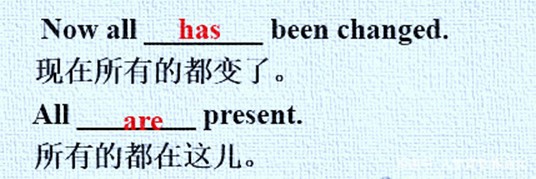中考中考英语语法的考点,涉及到主谓一致,共有三条原则:就近一致原则、意义一致原则、语法一致原则。
考查点一: 就近一致原则
和汉语不同,英语的主语和谓语单复数要一致,就近一致原则体现在语法上,就是谓语动词的单、复数形式取决于最靠近它的主语之单、复数。
1.由either…or, not…but…,neither…nor,not only…but also等连接并列主语时,谓语动词的数与最靠近它的主语保持一致。

2.当there be 句型中的主语是一系列事物时,谓语动词的数应与离其最近的主语保持一致。

3.here引导的句子里,主语有不止一个时,谓语动词通
常与离其最近的主语在数上保持一致。
考点二 :意义一致原则
1.有些集合名词,如family,class,team 等,作主语时,若看作整体时,谓语动词用单数形式;若强调其中的每个成员时,谓语动词用复数形式。

2.由all, either, neither, most, more, some, any, none 作主语时,若代表复数可数名词,谓语动词用复数形式;若代表单数可数名词或不可数名词,谓语动词用单数形式。

3.”分数或百分数+of+名词”以及”a lot of/lots of/plenty of/half of/the rest of/ (a) part of+名词”构成的短语作主语时,其谓语动词形式要以of后面的名词而定。名词是复数,谓语动词用复数形式;名词是单数,谓语动词用单数形式。

4.名词所有格之后的名词被省略,表示”商店、工厂、住宅”等意义时,作主语,谓语动词用单数形式。

5.politics,physics,works,the United States,news, maths 等词作主语时,谓语动词用单数形式。

6.表时间、距离、长度、价格、度量的词(短语)及动名词、动词不定式等作主语时,谓语动词用单数形式。加减乘除也常看作整体,谓语也用单数形式。

7.a number of 作主语时,谓语动词用复数形式;the number of 作主语时,谓语动词用单数形式。

考点三 :语法一致原则
1.由each以及some, any, no, every 等构成的复合不定代词作主语时,谓语动词用单数形式。

2.常以复数形式出现的名词,如glasses, shoes, trousers, chopsticks 等作主语时,谓语动词用复数形式。
3.主语后有with, together with, along with, besides, except, but, as well as 等引导的短语作插入语时,谓语动词与它前面的主语保持一致。
The teacher with his students is going to visit the museum. 老师和他的学生们将去参观博物馆。

4.由and或both…and连接的并列成分作主语时,谓语动词用复数形式。
Both he and I are right.
我和他都是对的。
5.单数可数名词或代词、不可数名词及动词不定式短语作主语时,谓语用单数形式;主语为复数可数名词或代词时,谓语动词用复数形式。
考点过关训练
Ⅰ.用括号中所给单词的适当形式填空(答案见所附图片)
1.There ________(be) some beef on the plate.
2.Not only you but also she ________(have) been to Paris.
3.Every day a number of people ________(come) to the park. The number of them ________ (be) about 700.
4.Fifty dollars ________ (be) enough.
5.The rich ________ (be) not always happy.
6.Nobody ________ (like) to be criticized.
7.Betty with her parents ________ (be) going camping.
8.The pair of shoes ________ (be) very expensive.
9.Neither we nor she ________ (have) been to the farm.

